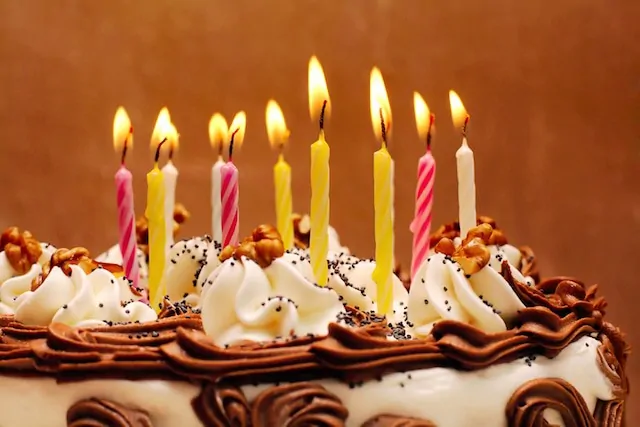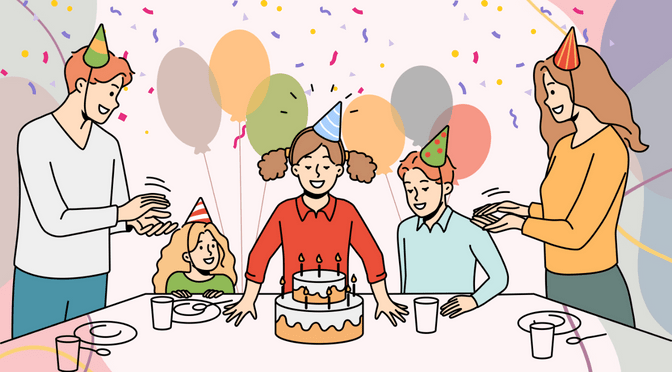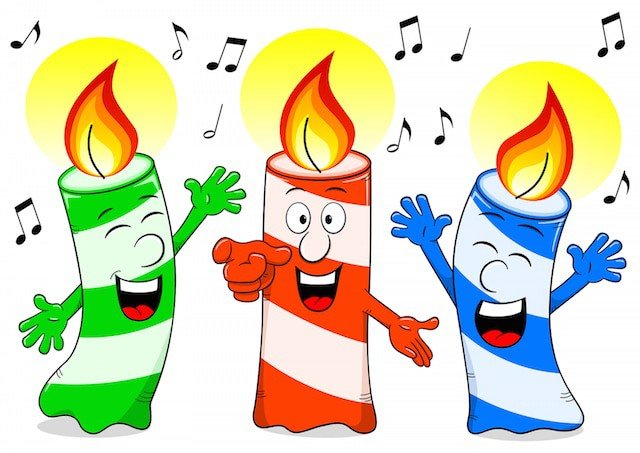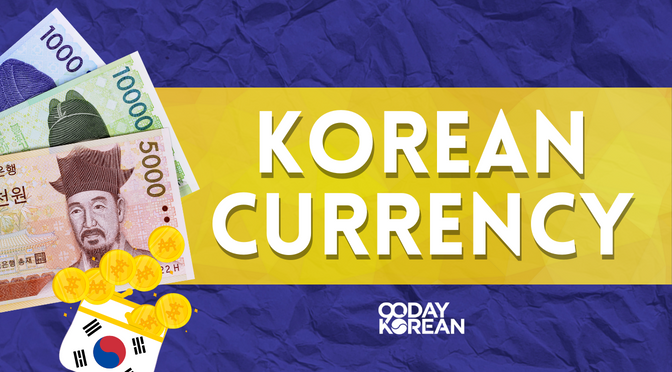In this article, we’ll learn how to say “Happy Birthday” in Korean.
There are a few different ways to say “Happy Birthday” in Korean, and you can also use the happy birthday verb for other situations. It’s quite useful!
Looking to get some singing practice? Well, you’re in luck, then. Not only will we explain that phrase, but we’ll also teach you the famous Happy Birthday song–in Korean!
Want to join the fun at your next Korean birthday party? To help you put what you’ve learned in this lesson to use, we made a PDF sing-along sheet for the Happy Birthday song in Korean. You can print this out or use it on your smartphone to sing the Korean version of the Happy Birthday song. Check it out below:
Contents
“Happy Birthday” in Korean
Maybe you have some Korean friends or a Korean significant other. Or you might be taking a trip to Korea soon, and want to make a good impression during your visit by studying this vocabulary. Then you’ll definitely want to know the words for “happy birthday” in Korean.
Before we dive in, check out this video on how to say “Happy Birthday” in Korean:
“Birthday” in Korean
The word “birthday” in Korean is 생일 (saengil). You can use this word when referring to your own birthday. You can also use it when referring to the birthday of somebody who is of a similar or younger age than yourself.
However, if you want to refer to the birthday of somebody who is a lot older than you, then you should use the word 생신 (saengsin) instead. You would likely use this version of “birthday” with people such as your grandparents or older relatives.
“Birthday” is one of those special Korean words that have an honorific version of the word, which is used when talking to people about a generation (or more) older than you. Honorifics in the Korean language are used to show respect to elders.
Some other nouns with this honorific form include “age” and “house.” Some verbs with an honorific form include “to exist,” “to eat,” and “to sleep.” These are keywords to know if you want to learn to speak Korean.
We’ll give you the different formal levels to pronounce it below in the 한글 (Hangeul), the Korean alphabet, with Romanization. But if you can’t read the Korean alphabet yet, it’d be a massive boost to your Korean learning if you did. It’s easy to learn, so why not give it a try?
Now, let’s go to the fun part! Let’s learn how to say “Happy birthday” in Korean.
How to Say “Happy Birthday” in Korean
Here are three ways to say “Happy Birthday” in Korean:
- 생신을 축하드립니다 (saengsineul chukadeurimnida)
- 생일 축하합니다 (saengil chukahamnida)
- 생일 축하해 (saengil chukahae)
Each of these phrases has a different level of formality and should be used appropriately depending on who you are speaking to.
We’ll explain each one and give you an audio guide on how to pronounce them.
“Happy Birthday” in Korean (formal)
The formal way to say “Happy Birthday” in Korean is 생신을 축하드립니다 (saengsineul chukadeurimnida). You can use this phrase when saying “happy birthday” to people who are much older than you. It uses the formal word for birthday.
Listen here:
The verb here is 축하하다 (chukahada), which means “to celebrate” or “to congratulate.” It’s combined with the verb 드리다 (deurida), which is the formal version of “to give.” You would use this version of happy birthday in Korean to show a lot of respect for the person you’re saying it to. You might use this with your grandparents or your professor at your university.
You can use a less formal version (such as the standard or informal version) of “Happy birthday” if it’s someone that is close to you and/or younger than you.
“Happy Birthday” in Korean (standard)
There are two ways to “Happy Birthday” in Korean that follow the standard form: 생일 축하합니다! (saengil chukahamnida) and 생일 축하해요! (saengil chukahaeyo). These versions are considered polite.
Listen Here:
Listen Here:
생일 축하합니다! (saengil chukahamnida) and 생일 축하해요! (saengil chukhahaeyo) are set phrases and can be used on most occasions. They are also the versions of “happy birthday” that appear on birthday cards.
The two versions are similar, except that the 합니다 (hamnida) version is slightly more formal.
The word 축하합니다 (chukahamnida) in 생일 축하합니다 (saengil chukahamnida) means “to congratulate”. You can say this word on its own if you want to congratulate somebody on achieving something.
If you only want to learn one way how to say “happy birthday” in Korean, then learn these phrases.
Saengil Chukhahaeyo Meaning
Saengil Chukhahaeyo means “Happy birthday.” It is the common Romanization of the Korean birthday greeting “생일 축하해요.” It’s a slightly less formal version 생일 축하합니다! (saengil chukahamnida) but is still considered polite.
“Happy Birthday” in Korean (informal)
“Happy Birthday” in Korean is 생일 축하해! (saengil chukahae). It’s considered the informal/casual version and can be used with friends of the same age.
Listen here:
It’s very similar to 생일 축하해요 (saengil chukahaeyo), except the final 요 (yo) is dropped at the end. This makes it much more informal. Use it wisely!
Some examples of people you might use this version of the phrase with would be close friends, young children, spouses, or siblings. Even though it’s informal, there is some benefit in using this “happy birthday” phrase appropriately. It shows a degree of closeness that you wouldn’t get with the other, more formal versions.
How to Write “Happy Birthday” in Korean
Here’s how to write Korean birthday greetings:
“Happy Birthday” in Korean (formal) → 생신을 축하드립니다
“Happy Birthday” in Korean (standard) → 생일 축하합니다 or 생일 축하해요
“Happy Birthday” in Korean (informal) → 생일 축하해
You can read our guide on Hangul Stroke Order to improve your Korean writing skills. Practice writing these phrases today, and let us know how you did in the comments section!
Birthdays in Korea
Here we’ll talk about the different beliefs, practices, and traditions when people celebrate birthdays in Korea.
Korean Birthday Food
Usually, on people’s birthdays, their friends or co-workers will buy them a birthday cake. The cake is then eaten as a group, like your co-workers or loved ones.
When buying a cake in Korea, you will often be asked how many candles 양초 (yangcho) you need. These candles, along with some matches, will be placed inside the cake’s box.
People often eat seaweed soup 미역국 (miyeokguk) on their birthday as this is a food that mothers often eat during pregnancy in Korea.
Korean Birthday Party
In the past, infant mortality was very high in Korea, so traditionally, a child’s first birthday is very important. Parents will throw a huge party, called a 돌잔치 (doljanchi), on this day. They will invite lots of people. If you live in Korea, you might end up being invited to such a party.
Korean Birthday Song
The Korean birthday song is a familiar song to many as it uses the tune of the English happy birthday song. The only difference would be the language used in the song.
In the section below, you’ll learn the Korean birthday song lyrics.
Happy Birthday Song in Korean
Here we’ll learn Happy Birthday in Korean Lyrics. This song follows the same tune as “happy birthday” in English and is very easy to learn.
♩ ♪ ♫
생일 축하합니다
생일 축하합니다
사랑하는 (insert name) 씨
생일 축하합니다
♪ ♫
saengil chukahamnida
saengil chukahamnida
saranghaneun (insert name) ssi
saengil chukahamnida
Wrap Up
Now that you know how to say AND sing “happy birthday” in Korean, why not write a birthday greeting too? Creating one will be easier if you learn about Korean sentence structure. Now, it’s time to go out and celebrate!









Thanks it really helps..
Sure, it’s our pleasure. We’re glad that it has been valuable to you. ^^
What is ” Happy Birthday to me” in korean? Because it’s my birthday today.
literally read the article again.
Thank you
It’s our pleasure, Ladan! Keep going! ^^
Thanks alot for this info… cumsamida ????????
Great! Keep going, Simran! ^^
Thank you very much for all this information very much appreciated. Kind regards Janet Ihaka.????????????
Thanks for the comment, Janet! Keep going! ^^
It’s very useful for me.
Thank you 🙂
Great, we’re glad that it’s been valuable to you. ^^